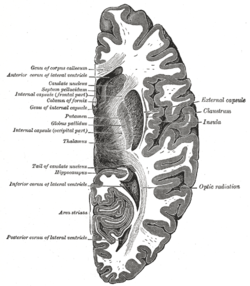| Lentiform nucleus | |
|---|---|
 Putamen and globus pallidus make up the lentiform nucleus. | |
 Two views of a model of the striatum (i.e. lentiform nucleus plus the caudate nucleus) of the right cerebral hemisphere: A, lateral aspect; B, medial aspect. | |
| Details | |
| Identifiers | |
| Latin | nucleus lentiformis |
| NeuroNames | 1234 |
| TA98 | A14.1.09.506 |
| TA2 | 5567 |
| FMA | 77615 |
| Anatomical terms of neuroanatomy | |
The lentiform nucleus (or lentiform complex, lenticular nucleus, or lenticular complex) are the putamen (laterally) and the globus pallidus (medially), collectively. Due to their proximity, these two structures were formerly considered one, however, the two are separated by a thin layer of white matter - the external medullary lamina - and are functionally and connectionally distinct.[1]
The lentiform nucleus is a large, lens-shaped mass of gray matter just lateral to the internal capsule. It forms part of the basal ganglia. With the caudate nucleus, it forms the dorsal striatum.
- ^ Standring, Susan (2020). Gray's Anatomy: The Anatomical Basis of Clinical Practice (42nd ed.). New York. pp. 503–504. ISBN 978-0-7020-7707-4. OCLC 1201341621.
{{cite book}}: CS1 maint: location missing publisher (link)